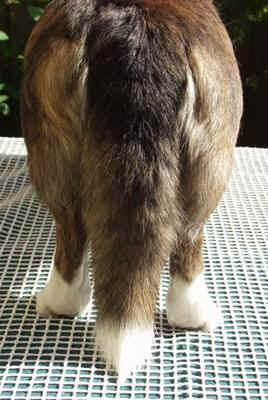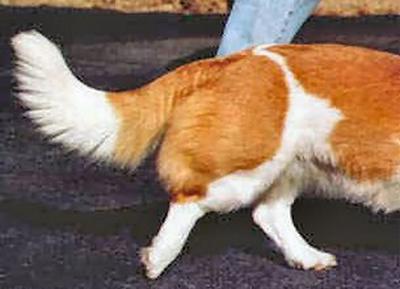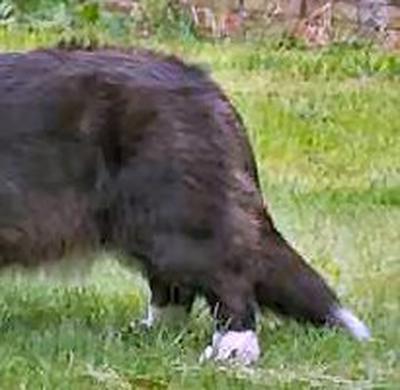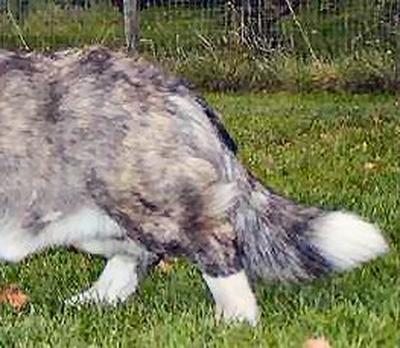The Cardigan tail |
||
UK standard: TAILSET A second functional
issue is the relationship between tail set and croup angle.
While this is only a reflection of the actual angle of the pelvis,
again it gives us a functional issue. As the pelvis rotates it influences
the range of motion of the hip joint.
That range of motion is limited by the shape of the ball and socket
joint. If
the pelvis is tilted forwards, giving a flatter angle, then the range of
motion is more shallow in under-reach and greater in follow-through.
If the pelvis is tilted backwards, then the range of motion is
deeper in under-reach and more shallow in follow-through.
A Cardigan needs a good balance between both functions –
under-reach and follow-through – so that it can move efficiently and
have good power in its full out run as it chases down livestock. Occasionally, in search for a low tail set, breeders have inadvertently
selected for a steeply angled croup. The end result being a dog with too much under-reach
and very restricted rear follow-through, sometimes resulting in a
sickle-hocked dog when moving.
(Quite often quaintly referred to as being a "Tummy-Tickler“) In terms of aesthetics, the long line flowing down from
the ears, neck, withers and back terminates abruptly when the tail set is
too high, giving the dog a squared off look in the rear.
The gentle curve over the croup and tail set called for by the
standard is a much more pleasing line to the eye.
Without a good understanding of the structural mechanics of the
rear, however, people may inadvertently select for the wrong combination
of traits in attempting to achieve that long curved line. TAIL TYPE Length of tail: The various commentaries to the standards
always mention length of tail, and feathering, as issues which are
important. While
the standards do not stipulate the maximum length of tail they do require
the tail to touch or nearly touch the ground.
This refers to the fleshy part of the tail, not merely the coat. Therefore in terms of length, the Cardigan tail should at
very least reach the hock joint and preferably be longer, to touch or
nearly touch the ground. Tail length should be measured when the dog is standing with the
tail hanging straight down and assessed as the overall length of the
vertebrae, not just the length of the hair at the tip. If, when in this position, the vertebrae has to bend to accomodate
the ground the tail is too long for the height of the dog. Tails can also stop short of the hocks and be too short.
Please check the tails for any kind of deformation including kinks
or clubbing at the tip, as these occasionally occur and should be
penalized in accordance with the standard of the country where you are
judging. Scientific research
indicates that such occurrences may be an indication of inherited spinal
abnormalities and are best avoided in breeding decisions. The Cardigan's tail
has been described as being like a fox's brush.
Noticeable in a fox's brush/tail is that the hairs are of
approximately equal length all around the tail, and stand out somewhat.A Cardigan tail with noticeable feathering on the underside would
therefore be considered a deviation, as would a thin, whippy tail. In
closing, it must be pointed out that there is a
distinct difference in the wording of the the UK and the US standards
regarding the tail set.
While in practice there seems to be little difference in what
breeders and judges from around the globe actually select, nonetheless
please note the differences in actual wording.
Taken literally, the UK standard would seem to prefer a slightly
higher tail set than the US standard.
|
||
|
|
|
| Cardigan tail of correct length moderately long, to touch or nearly touch ground" UK, "reaching well below hock" US). It shows its fox's brush, hairs are of aproximately equal length all around the tail. Tail set appears to be correct, or may be a bit high with this photo. Carriage cannot be determined here. | Good tail set, displaying the soft flowing curve over the croup. Although Number 1a shows a better "fox-like" brush, this tail on the red dog shows an acceptable brush and length would fall well below the hock. Please note that this dog would be more correct by having shorter hocks. This dog displays correct tail carriage while in motion, ("lifted a little above body when moving" UK,Carried low when standing or moving slowly, streaming out" US) | |
|
|
|
| Tail of correct length (moderately long, to touch or nearly touch ground" UK, "reaching well below hock" US). Brush appears correct, and set on is acceptable.Carriage cannot be determined here. | Tail of correct set, showing the soft flowing Length as described previously, is correct and it has a pleasing brush. Carriage cannot be determined here. | |
|
||




